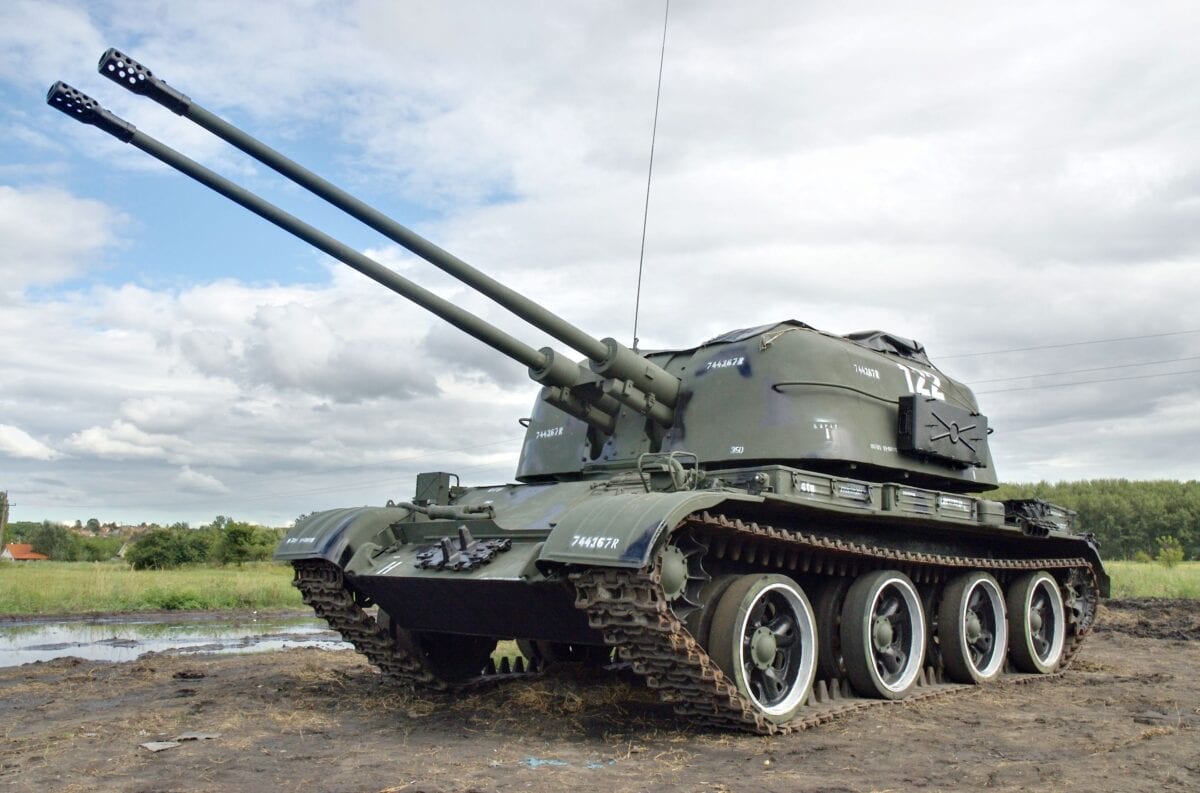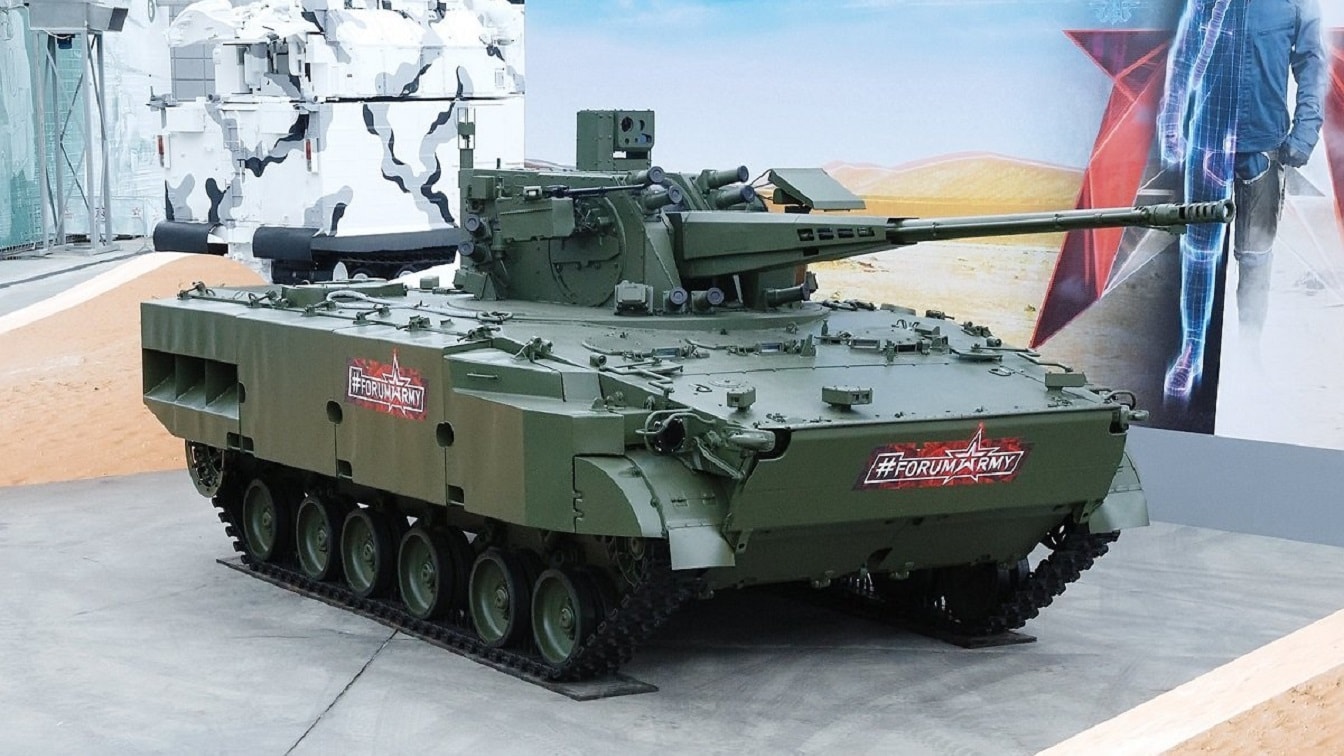Russia’s New Derivatsiya Vehicle A Big Rapid-Firing Gun to Shoot Down Drones, Missiles: Russia’s long-range surface-to-air missile systems such as the S-400 and S-500 can famously engage high-flying aircraft and ballistic missiles from hundreds of miles away. But as recently reported by the Russian press, Moscow plans to complete the development in 2022 of three new short-range air defense systems to defend against growing threats posed by surface-skimming missiles and kamikaze drones.
Enter Derivatsiya
Perhaps the most unusual of the new air defense systems is the 2S38 Derivatsiya-PVO (‘Derivation’), also designated the 1K150 and ZAK-57, which mates an automated AU-220M Baikal steel gun turret weighing 3.2 tons to the hull of a BMP-3 infantry fighting vehicle.
Its 2A90 57-millimeter autocannon can spit out two 6-pound shells per second out to a maximum aerial engagement range of 3.7 miles (6 kilometers), and it’s allegedly accurate enough to blast small drones from 3 kilometers away (1.86 miles) without using costly missiles.
The 21.5-ton Derivatsiya, which has a crew of three, is meant to provide low-altitude air defense for frontline mechanized units and airborne troops, replacing the venerable ZSU-23-4 Shilka. While the gun can’t reach high-flying warplanes and combat drones, it could pose a lethal threat to attack helicopters and close-support aircraft, and swat down incoming cruise missiles, precision-weapons launched by high-flying aircraft, small but lethal kamikaze drones, and allegedly even large-caliber artillery rockets.
That’s important, as Russian air defenses were vexed by swarms of cheap improvised drones employed by militant groups in Syria; and state-level adversaries might potentially deploy far more lethal systems in larger numbers.
Contrastingly, though the U.S. Army still uses non-mobile 20-millimeter Gatling cannons to protect bases against rockets, drones, and mortar shells, it no longer deploys medium-caliber self-propelled anti-aircraft guns (SPAAG) like the M15 half-tracks in World War II, or tracked M19 and M42 Duster armored vehicles during the Cold War. Today, U.S. development is focusing on lasers and jammers as affordable counters to drones and potentially even missiles.
Compared to lighter cannons, medium caliber shells are more likely to down aircraft with just a single direct hit and have greater energy to hit targets at longer distances. Historically, SPAAGs also inevitably see extensive use against ground targets. The Derivatsiya’s gun would be lethal not only against personnel but also (using new discarding-sabot shells) threaten most armored vehicles short of a main battle tank, including infantry fighting vehicles and light tanks.
Soviet Legacy
Derivatsiya is in fact something of a throwback to an earlier Soviet system developed in the 1950s. After World War II, the Red Army wanted more capable tracked armored air defense vehicles to escort its tank divisions into battle instead of the GAZ trucks and U.S.-built halftracks it relied on fighting the Nazis.

ZSU-57-2 Soviet self-propelled anti-aircraft gun.
This resulted in the ZSU-57-2, which combined a boxy, open-topped turret mounting twin S-68 57-millimeter autocannons atop the hull of a mainstay T-54 tank stripped of most of its armor. The bulky 31-ton vehicle had a crew of five and carried 300 shells in 4-round clips.
The long-barreled guns could each spit out one shell per second under realistic conditions which hit far harder than 20, 35- and 40-millimeter guns on NATO SPAAGs. Soviet research assessed just one direct hit from a 57-millimeter shells sufficed to destroy a fighter.
Soviet tank regiments, and some motor-rifle regiments, incorporated one or two four-vehicle ZSU-57 batteries. China produced its own Type 80 spinoff, mating the ZSU-57’s turret to the hull of a Type 69-II tank, as did North Korea, though using Chinese Type 59 tank hulls.
But despite its imposing stature at Soviet military parades, the ZSU-57 had few anti-aircraft successes on Cold War battlefields due to its slow-rotating turret, clunky mechanical targeting computer and lack of radar, leaving its powerful guns with poor odds of hitting fast jets.
Instead, the radar-directed ZSU-23-4 Shilka, equipped with quadruple 23-millimeter guns on a rapid-traversing turret, became the Soviet point air defense vehicle most dreaded by NATO and Israeli pilots after entering service in 1965.
ZSU-57s nonetheless saw extensive combat in the Arab-Israeli, Vietnam, Iran-Iraq (by both sides), and dissolution of Yugoslavia wars, usually with more success engaging ground targets than aerial ones. That said, Iraqi ZSU-57-2s did down several Iranian Cobra helicopters, as well as one or two British Tornado jets undertaking low-altitude raids during Operation Desert Storm. Countries still operating ZSU-57-2s today include Cuba, Egypt, Iran, Mozambique, North Korea and Syria.
Derivatsiya Has Some Stealthy Sensors
Intriguingly, the Derivatsiya doesn’t incorporate a radar like the Shilka or succeeding 2K22 Tunguska gun/missile system, instead relying on an OES-OP electro-optical/infrared system to detect approaching missiles and aircraft. Though a radar could have longer range, optical sensors are passive (don’t emit signals), leaving approaching aircraft unaware of being detected, and unable to counterattack with anti-radar missiles.
The OES-OP’s 360-degree surveillance mode allegedly could spot an A-10 Thunderbolt jet up to 4 miles away and an Israeli Eye-400 mini-drone (measuring 2 meters wide and .8 meters long) from 700 meters away. However, its focused scan mode can detect those up to 8 and 3 miles away respectively. The system’s thermal channel can also detect a 2 square meter object from 2 miles away, giving the system all-weather and night-time engagement capability.
The gunner can then “lock on” the digital fire control system to track a target (traversing up to 75 degrees upward) calculate a firing solution and open fire. The 57-millimeter shells have a muzzle velocity of Mach 2.9 and can engage targets traveling at a maximum speed of Mach 1.45.
Reportedly, the 2S38 can network its sensors and fire control to a command post presumably with access to additional sensors, or it can provide air defense independently using just its own sensors. However, external cuing of its focused-sensor mode may be required to engage fast-moving cruise missiles or artillery rockets, which may only be detected at short range by the area-surveillance mode due to small size. For example, a subsonic cruise missile approaching a at 600 miles per hour (268 meters per second) might leave the system just three seconds to react if detected 700 meters away.
Each 2S38 carries 148 shells, which could be expended in roughly one minute of continuous firing. Thus, 2S38s will be accompanied by 9T260 6×6 ammunition trucks stuffed with 592 more 57-millimeter shells and gun coolant liquid. These can reload two 2S38s simultaneously in 20 minutes. Two additional specialized trucks provide repair and maintenance support.
The Dervatsiya reportedly sports composite frontal armor resilient against 30-millimeter autocannons, supplementing an aluminum hull rated against heavy machineguns. It can optionally mount reactive armor to degrade shaped-charged anti-tank munitions, and has a laser-warning receiver linked to a reactive smoke dispenser to obscure it from targeting lasers.
The vehicle inherits from the BMP-3 amphibious capability, self-entrenching equipment, and a rear-mounted 500 horsepower diesel engine capable of propelling it to 43 miles per hour. It also sports hydropneumatic suspensions system which can be used to tilt the vehicle for optimal firing angles. That may help manage the gun’s inability to depress below -5 degrees, constraining ability to engage ground targets that are close or at lower elevation.
Smart Ammunition
The 2A90 gun is compatible with Russia’s extensive stocks of 53-OP-281 and 53-BR-281 shells meant for the ZSU-57-2. However, Russian firms are developing a new generation of shells claimed to greatly improve lethality, as pictured here.
These include the 3U08 multi-purpose shell which can be programmed to airburst at an optimal distance; to say burst above a trench, or to create a shrapnel cloud in the path of an incoming missile.
More exotically, there may be a guided smart shell in development which can maneuver using folding fins towards a targeted illuminated by the stabilized targeting laser mounted on the 2S38. This concept appears similar to the low-cost 70-millimeter laser-guided APKWS rocket developed by the U.S., but on a smaller munition without a rocket motor.
Reportedly, there is discussion of developing AI for the Deravitsya to autonomously identify and attack aerial threats without human intervention. That’s understandable given human reaction speeds may be incapable of acting swiftly enough against certain targets, but the cluttered environments of a battlefield could prove practically and ethically problematic for AI-directed engagement.
Time will tell if these technologies suffice to resurrect the increasingly rare gun-armed “anti-aircraft tank” in the 21st century.
Sébastien Roblin writes on the technical, historical and political aspects of international security and conflict for publications including the 19FortyFive, The National Interest, NBC News, Forbes.com and War is Boring. He holds a Master’s degree from Georgetown University and served with the Peace Corps in China. You can follow his articles on Twitter.

